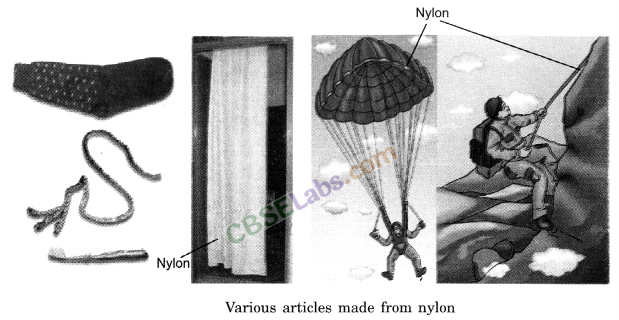CBSE Class 8 Science Notes Chapter 3 Synthetic Fibres and Plastics Pdf free download is part of Class 8 Science Notes for Quick Revision. Here we have given NCERT Class 8 Science Notes Chapter 3 Synthetic Fibres and Plastics.
CBSE Class 8 Science Notes Chapter 3 Synthetic Fibres and Plastics
Synthetic fibres and plastics, similar to natural fibres are made up of very large units. The larger units are called polymers. These are made up by combining many similar or dissimilar small units. The small units are called monomers.
Natural fibres are obtained from plant and animal sources, synthetic fibres are obtained by chemical processing of petrochemicals. The synthetic fibres can be woven into a fabric, just like natural fibres.
Synthetic fibres have a wide range of uses ranging from many household articles like ropes, buckets, furniture, containers, etc. to highly specialized use in aircrafts, ships, spacecrafts, health care, etc.
Depending upon the types of chemicals used for the manufacture, some synthetic fibres are rayon, nylon, polyester and acrylic.
Rayon or Artificial Silk
- It is a man-made fibre obtained from a natural source called wood pulp.
- It can be dyed in a wide variety of colours.
- Rayon is mixed with cotton to make bedsheets or mixed with wool to make carpets.
Nylon
- It was the first fully synthetic fibre. It was prepared from coal, water and air.
- Nylon fibres are strong, elastic, light, lustrous and easy to wash.

- It is used to make many items like socks, ropes, tents, toothbrushes, car seat belts, sleeping bags, curtains etc.
- Nylon is also used for making parachutes and ropes for rock climbing.
Polyester
- It remains crisp, wrinkle-free and easy to wash, so it is quite suitable for making dress material.
- Terylene can be drawn into very fine fibres that can be woven like any other yarn.
- PET (polyethene terephthalate) is used for making bottles, utensils, films, wires and many other useful products.
Acrylic is artificial wool.
Characteristics of Synthetic Fibres: They dry up soon, are durable, less expensive, readily available and easy to maintain.
Plastics: All plastics do not have the same kind of arrangement of small units. These can be either linear or cross-linked.
- Plastics can be easily moulded into any shape.
- Plastics can be recycled, reused, coloured, melted, rolled into sheets or made into wires.
- Thermoplastic is a plastic which gets deformed easily on heating and can be bent easily e.g., Polythene and PVC. These are used for manufacturing toys, combs, car grills and various types of containers.
- Thermosetting Plastics: There are some plastics which when moulded once cannot be softened by heating. These are called thermosetting plastics e.g., bakelite and melamine. Bakelite is used for making electrical switches, handles of various utensils etc. Melamine is used for making floor tiles, kitchenware etc.

The waste created by the synthetic fibres and plastics is not environment or eco¬friendly. On burning they create poisonous gases. On dumping in the ground they may take years to degenerate. This is because of their non-biodegrad able nature.
We need to use synthetic fibres and plastics in such a manner that we can enjoy their good qualities and at the same time minimise the environmental hazards for the living communities.
Petrochemicals: All the synthetic fibres are prepared by a number of processes using raw materials of petroleum origin, called petrochemicals.
Biodegradable: Materials which get decomposed through natural processes are called biodegradable.
Non-biodegradable: Those materials which are not easily decomposed by natural processes are called non-biodegradable.
Acrylic: These are the synthetic fibres which resemble natural wool. They are durable and affordable.
Artificial Silk: Artificial silk or rayon is a man-made fibre made from wood pulp. It has properties similar to that of silk.
Nylon: Nylon is a fully synthetic fibre. It is prepared from coal, water and air.
Plastic: Plastic is a polymer like synthetic fibre. Arrangement of units in some plastics is linear whereas in others it is cross-linked.
Polyester: Polyester is a synthetic fibre. Fabric made from this fibre does not get wrinkled easily. It remains crisp and is easy to wash.
Polymer: The word “Polymer” comes from two Greek words, poly meaning many and mer meaning part/unit. So polymer is made of many repeating units.
Polythene: Polythene (Poly + ethene) is an example of thermoplastic. It is used for making commonly used polythene bags.
Rayon: Rayon is also known as artificial silk. It is a man-made fibre made from wood pulp.
Synthetic Fibres: The fibres made by human beings are called synthetic fibres.
Terylene: Terylene is a popular polyester. It can be drawn into very fine fibres that can be woven like any other yarn.
Thermoplastics: Plastics which get deformed easily on heating and can be bent easily are known as thermoplastics.
Thermosetting Plastics: Plastics which when moulded once cannot be softened by heating are called thermosetting plastics.
We hope the given CBSE Class 8 Science Notes Chapter 3 Synthetic Fibres and Plastics Pdf free download will help you. If you have any query regarding NCERT Class 8 Science Notes Chapter 3 Synthetic Fibres and Plastics, drop a comment below and we will get back to you at the earliest.